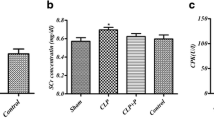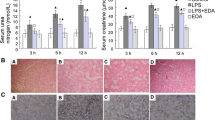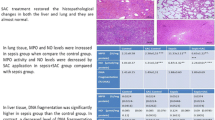Abstract
Sepsis progression is linked with the imbalance between reactive oxygen species and antioxidant enzymes. Thus, the aim of this study was to evaluate the effect of alpha-lipoic acid (ALA), a powerful antioxidant, in organs of rats submitted to sepsis. Male Wistar rats were subjected to sepsis by cecal ligation puncture (CLP) and treated with ALA or vehicle. After CLP (12 and 24 h), the myeloperoxidase (MPO) activity, protein and lipid oxidative damage, and antioxidant enzymes in the liver, kidney, heart, and lung were evaluated. ALA was effective in reducing MPO activity, lipid peroxidation in the liver, and protein carbonylation only in the kidney in 12 h after CLP. In 12 h, SOD activity increased in the kidney and CAT activity in the liver and kidney with ALA treatment. Thus, ALA was able to reduce the inflammation and oxidative stress in the liver and kidney after sepsis in rats.





Similar content being viewed by others
References
Hotchkiss, R.S., and I.E. Karl. 2003. The pathophysiology and treatment of sepsis. The New England Journal of Medicine. 348: 138.
Angus, D.C., W.T. Linde-Zwirble, J. Lidicker, G. Clermont, J. Carcillo, and M.R. Pinsky. 2001. Epidemiology of severe sepsis in the United States: analysis of incidence, outcome, and associated costs of care. Critical Care Medicine 29: 1303–10.
Marshall, J.C., D.J. Cook, N.V. Christou, G.R. Bernard, C.L. Sprung, and W.J. Sibbald. 1995. Multiple organ dysfunction score: a reliable descriptor of a complex clinical outcome. Critical Care Medicine 23: 1638–52.
Martin, G.S., D.M. Mannino, S. Eaton, and M. Moss. 2003. The epidemiology of sepsis in the United States from 1979 through 2000. The New England Journal of Medicine 348: 1546–54.
Murugan, R., V. Karajala-Subramanyam, M. Lee, S. Yende, L. Kong, M. Carter, C.D. Angus, and J.A. Kellum. 2010. Acute kidney injury in non-severe pneumonia is associated with an increased immune response and lower survival. Kidney International 77: 527–35.
Romero-Bermejo, F.J., M. Ruiz-Bailen, J. Gil-Cebrian, and M.J. Huertos-Ranchal. 2011. Sepsis-induced cardiomyopathy. Current Cardiology Reviews 7: 163–183.
Hochstadt, A., Y. Meroz, and G. Landesberg. 2011. Myocardial dysfunction in severe sepsis and septic shock: more questions than answers? Journal of cardiothoracic and vascular anesthesia 25: 526–35.
Andrades, M.E., C. Ritter, and F. Dal-Pizzol. 2009. The role of free radicals in sepsis development. Frontiers in Bioscience 1: 277–87.
Barichello, T., J.J. Fortunato, A.M. Vitali, G. Feier, A. Reinke, J.C. Moreira, J. Quevedo, and F. Dal-Pizzol. 2006. Oxidative variables in the rat brain after sepsis induced by cecal ligation and perforation. Critical Care Medicine 34: 886–9.
Matsukawa, A., M.H. Kaplan, C.M. Hogaboam, N.W. Lukacs, and S.L. Kunkel. 2001. Pivotal role of signal transducer and activator of transcription (Stat)4 and Stat6 in the innate immune response during sepsis. Journal of experimental medicine 193: 679–688.
Andrades, M., C. Ritter, M.R. de Oliveira, E.L. Streck, J.C.F. Moreira, and F. Dal-Pizzol. 2011. Antioxidant treatment reverses organ failure in rat model of sepsis: role of antioxidant enzymes imbalance, neutrophil infiltration, and oxidative stress. Journal of surgical research 167: e307–13.
Goraca, A., H. Huk-Kolega, A. Piechota, P. Kleniewska, E. Ciejka, and B. Skibska. 2011. Lipoic acid—biological activity and therapeutic potential. Pharmacological Reports 63: 849–858.
Abdel-Zaher, A.O., R.H. Abdel-Hady, M.M. Mahmoud, and M.M.Y. Farrag. 2008. The potential protective role of alpha-lipoic acid against acetaminophen-induced hepatic and renal damage. Toxicology 243: 261–270.
Bilska, A., and L. Włodek. 2005. Lipoic acid—the drug of the future? Pharmacological Reports 57: 570–7.
Singh, U., and I. Jialal. 2008. Alpha-lipoic acid supplementation and diabetes. Nutrition Reviews 66: 646–657.
Khabbazi, T., R. Mahdavi, J. Safa, and P. Pour-Abdollahi. 2012. Effects of alpha-lipoic acid supplementation on inflammation, oxidative stress, and serum lipid profile levels in patients with end-stage renal disease on hemodialysis. Journal of Renal Nutrition 22(2): 244–250.
Kang, K.P., D.H. Kim, Y.J. Jung, A.S. Lee, S. Lee, S.Y. Lee, K.Y. Jang, M.J. Sung, S.K. Park, and W. Kim. 2009. Alpha-lipoic acid attenuates cisplatin-induced acute kidney injury in mice by suppressing renal inflammation. Nephrology Dialysis Transplant 24: 3012–3020.
Gianturco, V., A. Bellomo, E. D'Ottavio, V. Formosa, A. Iori, M. Mancinella, G. Troisi, and V. Marigliano. 2009. Impact of therapy with alpha-lipoic acid (ALA) on the oxidative stress in the controlled NIDDM: a possible preventive way against the organ dysfunction? Archives of Gerontorology and Geriatrics 49: 129–133.
Wichterman, K.A., A.E. Baue, and I.H. Chaudry. 1980. Sepsis and septic shock—a review of laboratory models and a proposal. Journal of Surgical Research 29: 189–201.
Fink, M.P., and S.O. Heard. 1990. Laboratory models of sepsis and septic shock. Journal of Surgical Research 49: 186–196.
Li, G., L. Gao, J. Jia, X. Gong, B. Zang, and W. Chen. 2014. α-Lipoic acid prolongs survival and attenuates acute kidney injury in a rat model of sepsis. Clinical and Experimental Pharmacology and Physiology 41: 459–68.
De Young, L.M., J.B. Kheifets, S.J. Ballaron, and J.M. Young. 1989. Edema and cell infiltration in the phorbol ester-treated mouse ear are temporally separate and can be differentially modulated by pharmacologic agents. Agents Action 26: 335–341.
Esterbauer, H., and K.H. Cheeseman. 1990. Determination of aldehydic lipid peroxidation products: malonaldehyde and 4-hydroxynonenal. Methods in enzymology 186: 407–421.
Levine, R.L., D. Garland, and C.N. Oliver. 1990. Determination of carbonyl content in oxidatively modified proteins. Methods in Enzymology 186: 464–478.
Bannister, J.V., and L. Calabrese. 1987. Assays for superoxide dismutase. Methods of Biochemical Analysis 32: 279–312.
Aebi, H. 1984. Catalase in vitro. Methods in Enzymology 105: 121–6.
Lowry, O.H., N.J. Rosebrough, A.L. Farr, and R.J. Randall. 1951. Protein measurement with the Folin phenol reagent. The Journal of Biological Chemistry 193: 265–275.
Craciun, F.L., E.R. Schuller, and D.G. Remick. 2010. Early enhanced local neutrophil recruitment in peritonitis-induced sepsis improves bacterial clearance and survival. Journal of Immunology 185: 6930–8.
Osuchowski, M.F., F. Craciun, K.M. Weixelbaumer, E.R. Duffy, and D.G. Remick. 2012. Sepsis chronically in MARS: systemic cytokine responses are always mixed regardless of the outcome, magnitude, or phase of sepsis. Journal of Immunology 189: 4648–4656.
Oberholzer, A., C. Oberholzer, and L.L. Moldawer. 2001. Sepsis syndromes: understanding the role of innate and acquired immunity. Shock 16: 83–96.
Yang, S., C.S. Chung, A. Ayala, I.H. Chaudry, and P. Wang. 2002. Differential alterations in cardiovascular responses during the progression of polymicrobial sepsis in the mouse. Shock 17: 55–60.
Oberholzer, C., A. Oberholzer, M. Clare-Salzler, and L.L. Moldawer. 2001. Apoptosis in sepsis: a new target for therapeutic exploration. The FASEB Journal 15: 879–892.
Hattori, Y., K. Takano, H. Teramae, S. Yamamoto, H. Yokoo, and N. Matsuda. 2010. Insights into sepsis therapeutic design based on the apoptotic death pathway. Journal of Pharmacological Sciences 114: 354–365.
Olguner, C.G., U. Koca, E. Altekin, B.U. Ergür, S. Duru, P. Girgin, A. Taşdöğen, K. Gündüz, S. Güzeldağ, M. Akkuş M, et al. 2013. Ischemic preconditioning attenuates lipid peroxidation and apoptosis in the cecal ligation and puncture model of sepsis. Experimental and Therapeutic Medicine 5: 1581–1588.
Tsai, K.L., H.J. Liang, Z.D. Yang, S.I. Lue, S.L. Yang, and C. Hsu. 2014. Early inactivation of PKCε associates with late mitochondrial translocation of Bad and apoptosis in ventricle of septic rat. Journal of surgical research 186: 278–286.
Alvarez, S., and P.A. Evelson. 2007. Nitric oxide and oxygen metabolism in inflammatory conditions: sepsis and exposition to polluted ambients. Frontiers in Bioscience 12: 964–974.
Wang, P., and I.H. Chaudry. 1996. Mechanism of hepatocellular dysfunction during hyperdynamic sepsis. American Journal of Physiology 270: R927–938.
Suh, S.H., K.E. Lee, I.J. Kim, O. Kim, C.S. Kim, J.S. Choi, H.I. Choi, E.H. Bae, S.K. Ma, J.U. Lee, et al. 2014. Alpha-lipoic acid attenuates lipopolysaccharide-induced kidney injury. Clinical and Experimental Nephrology 19: 82–91.
Vanasco, V., M.C. Cimolai, P. Evelson, and S. Alvarez. 2008. The oxidative stress and the mitochondrial dysfunction caused by endotoxemia are prevented by alpha-lipoic acid. Free Radical Research 42: 815–823.
Cimolai, M.C., V. Vanasco, T. Marchini, N.D. Magnani, P. Evelson, and S. Alvarez. 2014. α-Lipoic acid protects kidney from oxidative stress and mitochondrial dysfunction associated to inflammatory conditions. Food & Function 5: 3143–50.
Safa, J., M.R. Ardalan, M. Rezazadehsaatlou, M. Mesgari, R. Mahdavi, and M.P. Jadid. 2014. Effects of alpha lipoic acid supplementation on serum levels of IL-8 and TNF-α in patient with ESRD undergoing hemodialysis. International Urology and Nephrology 46: 1633–8.
Halliwell, B., and J.M.C. Gutteridge. 1999. Free radicals in biology and medicine. Oxford: Oxford Science.
Arivazhagan, P., and C. Panneerselvam. 2000. Effect of DL-alphalipoic acid on neural antioxidants in aged rats. Pharmacological Research 42: 219–222.
Gasic-Milenkovic, J., C. Loske, and G. Munch. 2003. Advanced glycation end products cause lipid peroxidation in the human neuronal cell line SH-SY5Y. Journal of Alzheimer's Disease 5: 25–30.
Packer, L., E.H. Witt, and H.J. Tritschler. 1995. Alpha-lipoic acid as a biological antioxidant. Free Radical Biology & Medicine 19: 227–250.
Author information
Authors and Affiliations
Corresponding author
Rights and permissions
About this article
Cite this article
Petronilho, F., Florentino, D., Danielski, L.G. et al. Alpha-Lipoic Acid Attenuates Oxidative Damage in Organs After Sepsis. Inflammation 39, 357–365 (2016). https://doi.org/10.1007/s10753-015-0256-4
Published:
Issue Date:
DOI: https://doi.org/10.1007/s10753-015-0256-4




